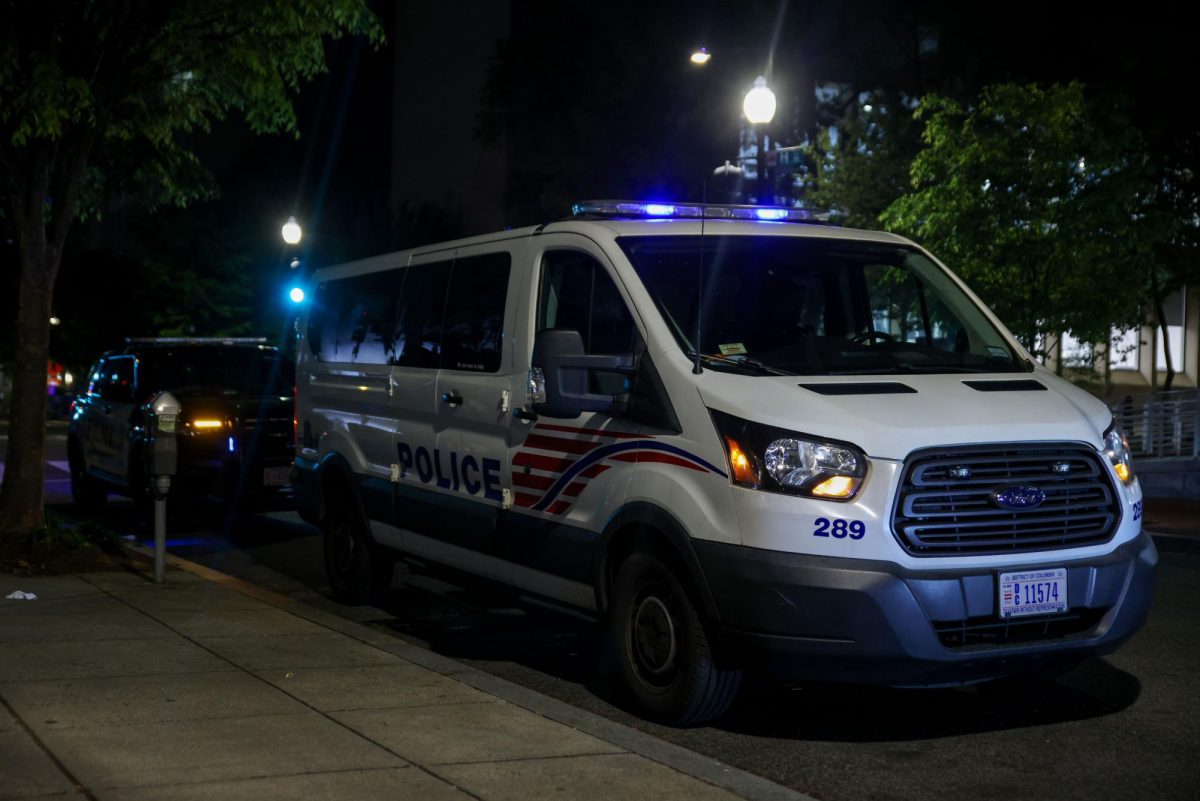Junior Faith Jensen presses the button for the elevator outside the ground level of the Marvin Center. Unable to open the door, she turns in her wheelchair and leaves.
Jensen says her next move is usually a phone call to Marvin Center operations. She talks to Mike Brown, the building’s maintenance director, or another employee who tells her the door is being fixed. Construction workers use the elevator to transport supplies for ongoing Marvin Center renovations, she is told, causing it to break down by damaging it with building materials or equipment.
Jensen then waits for someone to let her into the elevator from the inside, or she does not enter. If she does make it up to the platform outside J Street, she says she often finds the button to open the automatic door is also broken.
Jensen recounts the preceding events like she would describe any normal day, but a potentially life-threatening problem arose when she was in the Marvin Center during a fire alarm about two weeks ago. Jensen said people around her were unsure how to get her out of the building. She was eventually removed from her wheelchair and carried into the stairwell. Elevators cannot be used during a fire, and there was no alternate method of removing disabled students from University buildings.
Jensen is one of about 23 physically disabled GW students who work with Disability Support Services to get classes and housing in accessible buildings.
While Jensen said she is content at GW, she said the University has “done a very minimal amount” to accommodate students who need special access.
“They’ve done just as much as they have to,” she said.
Jensen said the Marvin Center elevator door has been broken since the end of last semester. The door worked when tested Wednesday.
Peter Konwerski, executive director of the Marvin Center, said all eight electric doors in the building worked as of last week, and he had not heard of any problems. Brown was unavailable for comment last week.
Kristy Willis, director of Disability Support Services, said she blames the current Marvin Center elevator door problem on the construction and said she believes it will be repaired when the renovations are finished.
The Marvin Center renovations include two more entrances, one on 21st Street and one on I Street, for disabled students and faculty members, Konwerski said. Recent renovations to the GW Bookstore, such as a ramp, will also accommodate students with disabilities.
As for emergency procedures, John Petrie, recently-hired assistant vice president for public safety and emergency management, said that although residence halls have guidelines for physically disabled students in an emergency, other University buildings lack a plan.
With input from disabled students and DSS, Petrie said he wrote a manual that will address accessibility issues in crisis situations and will be ready by fall.
“It will tell people who are in charge of groups or places the very simple things they need to plan for,” he said.
Petrie said during the fire alarm, which occurred March 29, Jensen should have been moved to a fire tower, like the fire-proof stairwell on the H Street side of the Marvin Center, and then removed from the building by police or fire personnel trained to move disabled people.
Freshman Soo Lee said she is one of a few disabled students living at the Mount Vernon Campus. Born with cerebral palsy, Lee uses a scooter for transportation. She lives on the lower floor of Merriweather Hall, which has no elevator.
Lee said housing officials told her New Hall was the only Foggy Bottom residence hall that can accommodate her scooter, which is larger than a normal wheelchair. She planned to live in the less expensive JBKO, but said the financial aid office will help her and her roommate afford the room.
“I mean I’m not complaining; I’m living in New Hall,” Lee said.
Lee said she also has trouble accessing the Marvin Center and Academic Center but said one of her biggest concerns is the MVC shuttle. Only two of the four shuttles are equipped with a lift, and she said the lifts routinely break.
Willis said “most students with disabilities are generally accommodated naturally” at GW because of its urban setting with few hills and relatively smooth concrete surfaces.
GW Disability Support Services in 1978. Willis said the department serves about 600 students a year with disabilities ranging from attention deficit disorder to physical and psychological conditions.
Freshman John Lucks, who met with Petrie and about six other disabled students this semester, said DSS is “really good about making sure that everything is all right.” Paralyzed from the waist down from a condition called spina bifida, Lucks uses braces to walk and said his only problem at GW occurred when the elevator in the West End broke. Instead of fixing the elevator, Lucks said the University moved him to Madison Hall.
With the exception of students who have mobility impairments and need barrier-free rooms, all students with disabilities were required to participate in the housing lottery for the first time this year, Willis said.
Willis said GW takes care of student needs on an individual basis if students are unable to find suitable building.
Jensen, who is married, decided to live off campus this year.
Willis said five residence halls are accessible to students who need special access. She said the “retrofit process,” the upgrading of access on older buildings, is slow. Lee agreed, saying while the new Somers Hall addition is completely accessible, GW renovated her current Merriweather room over the summer so she could live at Mount Vernon.
Jensen said she has had classes move from older Foggy Bottom buildings, like Monroe, to newer, more accessible ones like the Media and Public Affairs Building. She said she hopes GW increases accessibility in more buildings.
“I paid just as much money as everyone else does to go here,” said Jensen, who transferred to GW from a community college in central Florida last year. “There are a lot more opportunities in a place like D.C. . investing a little more money on new buildings does not seem like such a big deal.”







